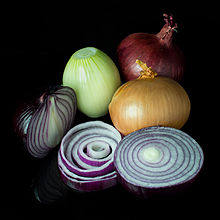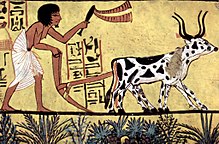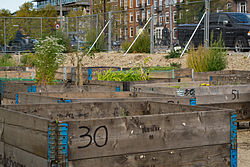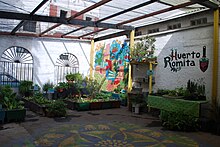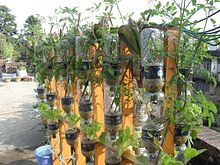The
onion (
Allium cepa L., from Latin
cepa "onion"), also known as the
bulb onion or
common onion, is a
vegetable and is the most widely cultivated species of the genus
Allium.
This genus also contains several other species variously referred to
as onions and cultivated for food, such as the Japanese bunching onion (
Allium fistulosum), the
tree onion (
A. ×
proliferum), and the Canada onion (
Allium canadense).
The name "
wild onion" is applied to a number of
Allium species, but
A. cepa
is exclusively known from cultivation.
Its ancestral wild original form
is not known, although escapes from cultivation have become established
in some regions.
[2]
The onion is most frequently a
biennial or a
perennial plant, but is usually treated as an
annual and harvested in its first growing season.
The onion plant has a fan of hollow, bluish-green leaves and the bulb
at the base of the plant begins to swell when a certain day-length is
reached.
In the autumn (or in spring, in the case of overwintering
onions), the foliage dies down and the outer layers of the bulb become
dry and brittle.
The crop is harvested and dried and the onions are
ready for use or storage.
The crop is prone to attack by a number of
pests and diseases, particularly the
onion fly, the
onion eelworm, and various fungi cause rotting.
Some varieties of
A. cepa, such as
shallots and
potato onions, produce multiple bulbs.
Onions are cultivated and used around the world. As a food item, they are usually served cooked, as a
vegetable or part of a prepared savoury dish, but can also be eaten raw or used to make
pickles or
chutneys.
They are pungent when chopped and contain certain chemical substances which irritate the eyes.
Onion

Roots, leaves and developing bulb

Umbel of onion flowers
Taxonomy and etymology
The onion plant (
Allium cepa), also known as the bulb onion
[3] or common onion,
[4] is the most widely cultivated species of the genus
Allium.[5][6]
It was first officially
described by
Carl Linnaeus in his 1753 work
Species Plantarum.
[7]
A number of synonyms have appeared in its taxonomic history:
- Allium cepa var. aggregatum – G. Don
- Allium cepa var. bulbiferum – Regel
- Allium cepa var. cepa – Linnaeus
- Allium cepa var. multiplicans – L.H. Bailey
- Allium cepa var. proliferum – (Moench) Regel
- Allium cepa var. solaninum – Alef
- Allium cepa var. viviparum – (Metz) Mansf.[8][9]
A. cepa is known exclusively from cultivation,
[10] but related wild species occur in Central Asia. The most closely related species include
A. vavilovii (Popov & Vved.) and
A. asarense (R.M. Fritsch & Matin) from
Iran.
[11]
However, Zohary and Hopf state that "there are doubts whether the
A. vavilovii collections tested represent genuine wild material or only
feral derivatives of the crop."
[12]
The vast majority of cultivars of
A. cepa belong to the "common onion group" (
A. cepa var.
cepa) and are usually referred to simply as "onions". T
he Aggregatum group of cultivars (
A. cepa var.
aggregatum) includes both shallots and potato onions.
[13]
The genus
Allium also contains a number of other species
variously referred to as onions and cultivated for food, such as the
Japanese bunching onion (
A. fistulosum), Egyptian onion (
A. ×
proliferum), and Canada onion (
A. canadense).
[4]
Cepa is commonly accepted as Latin for "onion" and has an affinity with Ancient Greek: κάπια (
kápia), Albanian:
qepë, Aromanian:
tseapã, Catalan:
ceba, English: chive, Occitan:
ceba, Old French:
cive, and Romanian:
ceapă.
Description
The onion plant has been grown and selectively bred in cultivation for at least 7,000 years. It is a
biennial plant,
but is usually grown as an annual.
Modern varieties typically grow to a
height of 15 to 45 cm (6 to 18 in).
The leaves are yellowish-green and
grow alternately in a flattened, fan-shaped swathe.
They are fleshy,
hollow, and cylindrical, with one flattened side.
They are at their
broadest about a quarter of the way up beyond which they taper towards a
blunt tip.
The base of each leaf is a flattened, usually white sheath
that grows out of a
basal disc.
From the underside of the disc, a bundle of
fibrous roots
extends for a short way into the soil.
As the onion matures, food
reserves begin to accumulate in the leaf bases and the bulb of the onion
swells.
[14]
In the autumn, the leaves die back and the outer scales of the bulb
become dry and brittle, and this is when the crop is normally harvested.
If left in the soil over winter, the growing point in the middle of the
bulb begins to develop in the spring.
New leaves appear and a long,
stout, hollow stem expands, topped by a bract protecting a developing
inflorescence.
Historical use
The
inflorescence takes the form of a globular
umbel of white flowers with parts in sixes.
The seeds are glossy black and triangular in cross section.
[14]
Bulbs from the onion family are thought to have been used as a food source for millennia.
In
Bronze Age settlements, traces of onion remains were found alongside
date stones and
fig remains that date back to 5000 BC.
[15]
However, it is not clear if these were cultivated onions.
Archaeological and literary evidence such as the
Book of Numbers 11:5 suggests that onions were probably being cultivated around 2000 years later in
ancient Egypt, at the same time that
leeks and
garlic were cultivated.
Workers who built the
Egyptian pyramids may have been fed
radishes and onions.
[15]
The onion is easily propagated, transported, and stored.
The ancient
Egyptians revered the onion bulb, viewing its spherical shape and
concentric rings as symbols of eternal life.
[16]
Onions were even used in Egyptian burials, as evidenced by onion traces being found in the eye sockets of
Ramesses IV.
[17]
In
ancient Greece, athletes ate large quantities of onion because it was believed to lighten the balance of the blood.
[16]
Roman
gladiators were rubbed down with onions to firm up their muscles.
[16]
In the
Middle Ages, onions were such an important food that people would pay their rent with onions, and even give them as gifts.
[16]
Doctors were known to prescribe onions to facilitate bowel movements and erections, and to relieve headaches, coughs,
snakebite, and hair loss.
[16]
Onions were taken by the first European settlers to
North America, where the
Native Americans
were already using wild onions in a number of ways, eating them raw or
cooked in a variety of foods.
They also used them to make into syrups,
to form
poultices, and in the preparation of
dyes.
According to diaries kept by the colonists, bulb onions were one of the first things planted by the
Pilgrim fathers when they cleared the land for cropping.
[16]
Onions were also prescribed by doctors in the early 16th century to
help with infertility in women.
They were similarly used to raise
fertility levels in
dogs,
cats, and
cattle, but this was an error, as recent research has shown that onions are toxic to dogs, cats,
guinea pigs, and many other animals.
[18][19][20]
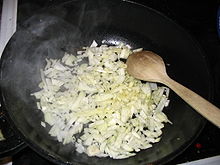
Sautéing onions

Large-scale cultivation
Check Out The Wikipedia Page for the rest of the story on Onions
Source: Wikipedia.org https://en.wikipedia.org/wiki/Onion
TTFN
CYA Later Taters!
Thanks for stopping by.
Donnie/ Sinbad the Sailor Man


